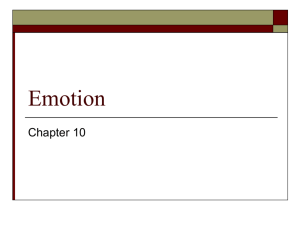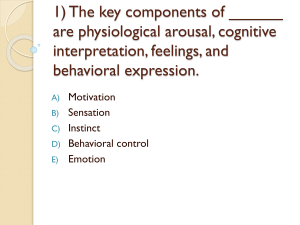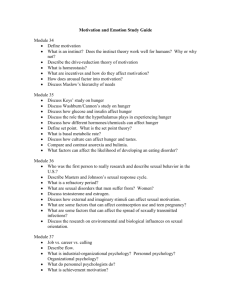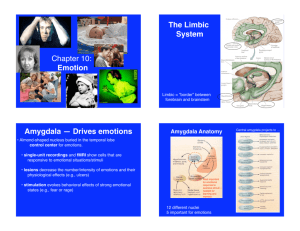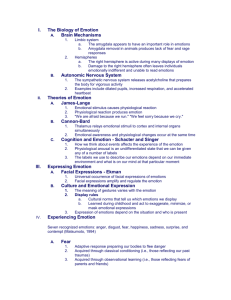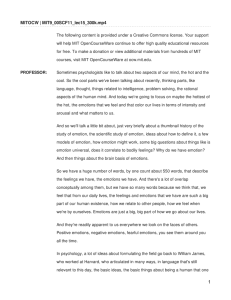Emotion and motivation
advertisement
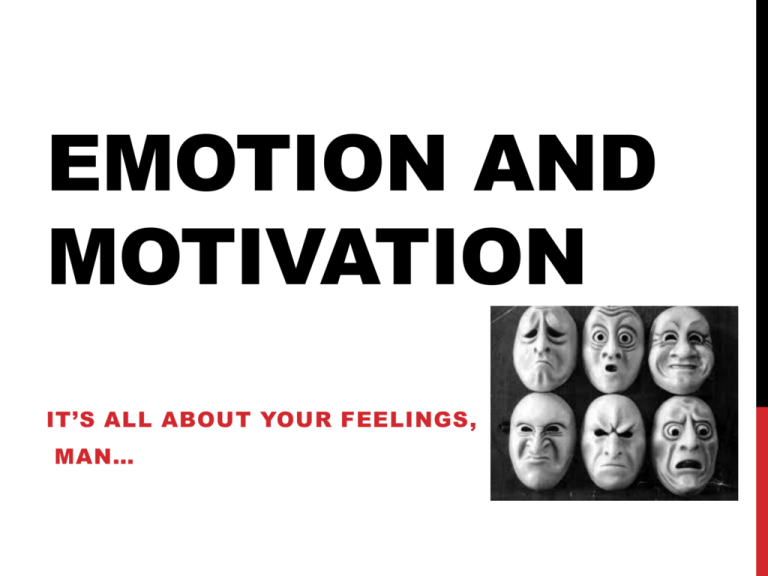
EMOTION AND MOTIVATION IT’S ALL ABOUT YOUR FEELINGS, MAN… THEORIES OF EMOTION James-Lange theory: stimuli trigger activity in the autonomic nervous system which in turn produces an emotional experience in the brain *You see the bear, THEN you experience fear, which is simply your experience of your body’s activity THEORIES OF EMOTION (2) Cannon-Bard theory: a stimulus simultaneously triggers activity in the autonomic nervous system and emotional experience in the brain *ANS reacts too slowly to account for the rapid onset of emotional experience *People often have difficulty accurately detecting changes in their own autonomic activity, such as heart rate *Nonemotional stimuli can cause identical patterns of ANS activity *Not enough unique patterns of ANS activity to account for all emotions THEORIES OF EMOTION (3) Schachter and Singer’s Two-Factor Theory: emotions are inference about the causes of undifferentiated physiological arousal *People misattribute their arousal to other stimuli in their environments and the inferences people draw about the causes of their arousal can influence their emotional experience EMOTIONAL BRAIN Klüver-Bucy syndrome: damage to limbic system of the brain produces lack of fear, hypersexual behavior, willingness to eat anything *Limbic system is implicated in the experience of emotions such as pleasure *Amygdala: limbic structure that plays a key role I production of emotion Appraisal: evaluation of the emotion-relevant aspects of a stimulus *Primarily the amygdala’s job KLÜVER-BUCY! AMYGDALA, HOLLA Two pathways of information processing: 1. Fast pathway, which goes straight from the thalamus to the amygdala 2. Slow pathway, which goes from the thalamus to the cortex and THEN to the amygdala Cortex processes information and tells the amygdala whether to maintain an emotion or decrease it *Cortex = brakes, Amygdala = gas pedal REGULATION OF EMOTION Emotion regulation: the cognitive and behavioral strategies people use to influence their own emotional experience *Cognitive strategies: reappraisal, changing one’s Emotional Experience by changing the meaning of the emotion-eliciting stimulus *Emotions are reactions to the APPRAISAL of the event, not the event itself, so changes in appraisal bring about changes in emotion *Inability to reappraise events lies at the heart of psychiatric disorders, such as depression FOR EXAMPLE EMOTIONAL COMMUNICATION Emotional Expression: an observable sign of an emotional state Charles Darwin: “People and animals share certain facial and postural expressions. These serve as a means by which organisms communicate information about their internal states to each other” *E.g. establishing “pecking orders” without spilling blood UNIVERSALITY HYPOTHESIS Universality Hypothesis: emotional expressions have the same meaning for everyone *People are quite accurate at judging emotional expressions of members of other cultures *People who have never seen a human face make the same facial expressions as those who have Facial Feedback Hypothesis: emotional expression can cause the emotional experiences they signify *Observers unconsciously mimic the body postures and facial expressions of the people they are watching *Tell what others are feeling simply by making the same faces DECEPTIVE EXPRESSION Display rules: norms for the control of emotional expression *Intensification: exaggerating emotion *Deintensification: muting expression of emotion *Masking: expressing one emotion while feeling another *Neutralizing: feeling an emotion but displaying no expression *People are better at recognizing the facial expression of people from their own cultures display rules to blame? LEAKY BODIES Morphology: certain facial muscles tend to resist conscious control * “Reliable Muscles” reveal emotion involuntarily Symmetry: sincere expressions tend to be symmetrical Duration: sincere expressions tend to last between a half second and 5 seconds Temporal patterning: insincere expressions tend to have moe abrupt onsets and offsets LIE DETECTION Humans are bad at telling when other humans are lying Liars are often TOO SMOOTH in their lies *Sincere speech includes superfluous details, spontaneous corrections, and expressions of self-doubt People have a bias towards believing others People don’t know what to focus on and what to ignore *Talking quickly and averting gaze are NOT actually correlated with lying but… *Speaking too little and repeating words ARE WHAT MAKES YOU DO THINGS? Motivation: the purpose for or cause of an action Capgras syndrome: temporal lobe (where faces are identified) and limbic system (where emotions are generated) *Emotions tell us information about the world *People use current emotions as information about the quality of their lives *Emotions help us make decisions, choose from a number of options BUT DEEP, DEEP DOWN… Hedonic Principle: the notion that all people are motivated to experience pleasure and avoid pain Drive Reduction Theory: action is motivated by the urge to satisfy drives and return to homeostasis *Drive: an internal state generated by departures from physiological optimality *Homeostasis: the tendency for a system to take action to keep itself in a particular state EATING AND BREEDING Maslow Pyramid HUNGRY LIKE THE WOLF Hunger: physiologically, controls the urge to eat. *Leptin is a chemical secreted by fat cells, is an anorexigenic signal that tells the brain to switch hungers off *Ghrelin is a chemical produced in the stomach, sends orexigenic signal that tells the brain to switch hunger on *Hypothalamus receives chemical signals about hunger EATING DISORDERS Hunger isn’t just physiological! Bulimia Nervosa: an eating disorder characterized by binge eating followed by purging *Vicious cycle: bulimic people eat to decrease negative emotions but experience more negative emotions at the thought of getting fat; these negative emotions lead them to purge Anorexia Nervosa: disorder characterized by intense fear of being fat and severe restriction of food intake *Warped body image *High levels of ghrelin in blood! SEX! Sexual motivations are vital for the continuation of any species Humans are weird! Estrogen levels regulate ovulation in human females but NOT sex drive! *Testosterone? Human Sexual Response Cycle: stages of physiological arousal during sexual activity *William Masters and Virginia Johnson measured physical responses of hundreds of volunteers as they had sex in a laboratory! KINDS OF MOTIVATION Intrinsic Motivation: motivation to take actions that are themselves rewarding (painting, listening to music, watching music, eating delicious food) Extrinsic Motivation: motivation to take actions that lead to reward Ability to delay gratification high grades in school Overjustification effect Threats can suggest that forbidden activity is desirable! MANAGEMENT THEORY Theory X: Manager believe that employees will work only if rewarded with benefits or threatened with punishment (Behaviorist Management?) Theory Y: Managers believe that employees are internally motivated to do good work and policies should encourage this internal motive (INTERNAL motivation) Theory Y seems to be more effective management strategy across cultures Similarities to your schooling? Grades? CONFLICTING MOTIVATIONS! Approach-Approach Conflicts: two attractive motivations compete Avoidance-Avoidance Conflicts: two unattractive motivations compete Approach-Avoidance Conflicts: one event or goal has both attractive and unattractive features *College selection quandary! HUMANS ARE TERRIBLE AT PREDICTING EMOTIONAL OUTCOMES! Would you rather: win the lottery or become a paraplegic? Mysteries create lasting emotional impressions—however most people want to know the “why” “what” and “how” of emotional stimuli HUMANS ARE EMOTIONALLY IRRATIONAL Disgust: a defensive response that ensures improper substances do not enter our bodies through our mouths, noses, or other orifices Irrational rules: 1. The contagion rule suggest that two tings that were once in contact will continue to share their properties 2. Similarity rule suggests that two things that are similar in appearance share properties

